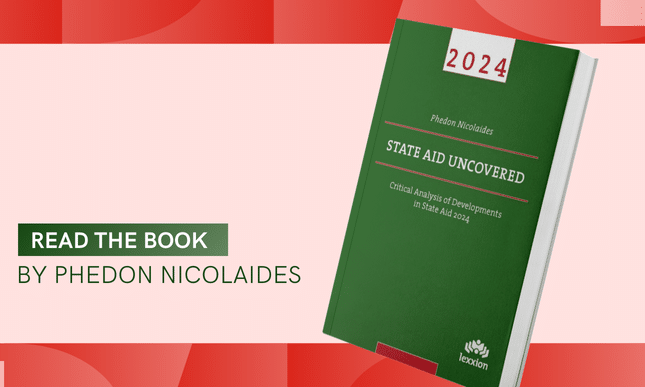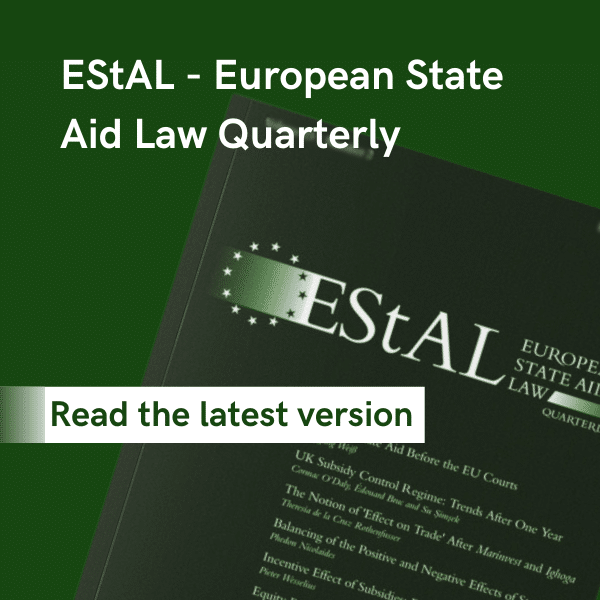
Introduction
A perennial question is whether competitors of aid recipients have legal standing to appeal against Commission decisions that either authorise aid or find that a public measure does not constitute State aid. The answer depends on whether the Commission decision is adopted without the opening of the formal investigation procedure or after a form investigation. It is easier to challenge a decision as an “interested party” when the Commission, for example, authorises aid without a prior formal investigation.
On 29 January 2025, the General Court, in case T-334/22, Danske Fragtmænd v Commission, addressed the difficult part of that question in its assessment of the appeal of Danske Fragtmænd [DF] against Commission decision 2022/459 on aid measures SA.49668 and SA.53403 by Denmark and Sweden, respectively, in favour of PostNord AB and Post Danmark.[1]
The aid concerned injection of capital into PostNord in 2017 by the two countries. The amounts were EUR 23 million by Denmark and EUR 35 million by Sweden. Subsequently, PostNord increased the capital of its wholly owned subsidiary – Post Danmark – by EUR 314 million.
In September 2021, following a formal investigation, the Commission adopted decision 2022/459 by which it found that the capital injection from PostNord Group into Post Danmark did not confer an advantage and, therefore, that measure did not constitute State aid. By contrast, it held that the capital injections from Denmark and Sweden into PostNord constituted unlawful and incompatible aid and ordered its recovery from PostNord.
DF, a Danish company operating in the market for road transport of goods and parcel distribution services, objected to the Commission’s finding that the investment by PostNord into Post Danmark was free of State aid.
The judgment dealt with a single issue: whether DF, as a competitor of Post Danmark, had standing to challenge the Commission decision.
Three possibilities for legal standing
The General Court, first, recalled that “(19) under the fourth paragraph of Article 263 TFEU, any natural or legal person may, under the conditions laid down in the first and second paragraphs of that article, institute proceedings against an act addressed to that person or which is of direct and individual concern to them, and against a regulatory act which is of direct concern to them and does not entail implementing measures.”
In other words, Article 263 prescribes appeals can be lodged by those that fall into one of the following groups:
- The addressee of an EU act.
- A person who is directly and individually concerned by an EU act.
- A person who is directly concerned by an EU regulatory act.
However, as is well-known, Commission decisions are addressed to Member States. The notification of State aid and any subsequent exchanges between the Commission and Member States concerning the absence of aid or the compatibility of aid with the internal market are bilateral procedures between the Commission and Member States. Undertakings and other third parties have no formal role, apart from the right to submit comments to the Commission when it opens a formal investigation. Therefore, the General Court, not surprisingly, held that, given that the Commission decision was addressed to Denmark and Sweden, “(20) the present action cannot be declared admissible under the first limb of the fourth paragraph of Article 263 TFEU.” Furthermore, “(21) the capital injections […] are individual in nature. Thus, the contested decision cannot be classified as a regulatory act within the meaning of the third limb of the fourth paragraph of Article 263 TFEU […] The present action cannot therefore be declared admissible on that basis.
Consequently, “(22) the present action for annulment is admissible only if the applicant is, in accordance with the second limb of the fourth paragraph of Article 263 TFEU, directly and individually concerned by the contested decision, those two conditions being cumulative.”
Next, the General Court examined whether DF was individually concerned.
Of individual concern?
The General Court, first, recalled the relevant principles.
“(24) Persons other than those to whom a decision is addressed may claim to be individually concerned only if that decision affects them by reason of certain attributes which are peculiar to them or by reason of circumstances in which they are differentiated from all other persons and, by virtue of those factors, distinguishes them individually just as in the case of the person addressed by such a decision”.
“(25) As regards more specifically the field of State aid, an applicant challenging the merits of a decision appraising the aid taken at the end of the formal investigation procedure must demonstrate that it has a particular status […] That applies in particular where the applicant’s position on the market concerned is substantially affected by the aid to which the decision at issue relates”.
Therefore, the General Court points out that in the field of State aid there is a practical criterion for determining whether a company is individually concerned by an aid measure. That is whether the aid substantially harms its market position.
“(26) The substantial adverse effect on the applicant’s competitive position on the market in question results not from a detailed analysis of the various competitive relationships on that market, allowing the extent of the adverse effect on its competitive position to be established specifically, but, in principle, from a prima facie finding that the grant of the measure covered by the Commission’s decision leads to a substantial adverse effect on that position”.
“(27) It follows that that condition may be satisfied where the applicant adduces evidence to show that the measure at issue is liable to have a substantial adverse effect on its position on the market concerned”.
However, the harm cannot be incidental.
“(28) With regard to the determination of a significant effect on the position on the market in question, it must be borne in mind, first, that the mere fact that an act may influence the competitive relationships existing on the relevant market and that the undertaking concerned was in a competitive relationship with the beneficiary of that act cannot in any event suffice for that undertaking to be regarded as being individually concerned by that act. Therefore, an undertaking cannot rely solely on its status as a competitor of the undertaking in receipt of aid”.
“(29) Second, it must be borne in mind that demonstrating a substantial adverse effect on a competitor’s position on the market cannot simply be a matter of the existence of certain factors indicating a decline in the applicant’s commercial or financial performance, such as a significant decline in turnover, appreciable financial losses or a significant reduction in market share following the grant of the aid in question. The grant of State aid can also have an adverse effect on the competitive situation of an operator in other ways, in particular by causing the loss of an opportunity to make a profit or a less favourable development than would have been the case without such aid”.
Then the General Court applied the above principles to the case at hand.
The aid must have a causal effect
A mere competitive relationship or involvement in the formal investigation procedure is not enough.
The General Court, first, noted that DF was in a competitive relationship with Post Danmark. Next, it observed that “(32) as regards the applicant’s role in the administrative procedure before the Commission, the applicant rightly submits that it played an active role. The applicant submitted observations in the context of the formal investigation procedure as an interested party. Nonetheless, in any event, it cannot be inferred from the mere participation of the applicant in the administrative procedure that it is individually concerned by the contested decision, even if it played an important role in that administrative procedure”.
“(33) In the second place, as regards the substantial effect on its market position, […], the applicant claims to have lost a significant number of customers and approximately 30% of its market share due to Post Danmark ‘[dumping] its prices below any competitive level’ thanks to the capital injections […] At the reply stage, the applicant also maintained that the grant of the capital injections at issue had led to a change in the behaviour of customers, who decided no longer to use its services. Thus, the applicant claims that, before those capital injections were granted, it lost customers to various competitors, whereas, after those injections were granted, it lost customers almost exclusively to Post Danmark.”
“(35) In that regard, first, it should be noted that the applicant’s claim that it lost approximately 30% of its market share must be rejected, since it is not supported by prima facie evidence.”
“(36) Second, as regards the applicant’s line of argument, […], relating to the alleged change in the behaviour of customers who decided no longer to use its services, it should be noted that the applicant refers to the lists of customers allegedly lost to PostNord. The first of those lists, which partly covers the period prior to the grant of the measures at issue, identifies several undertakings the applicant’s former customers allegedly made use of, unlike the other two lists, which identify only PostNord.”
“(38) The lists of customers allegedly lost to PostNord must all be understood as identifying the customers who left the applicant to switch exclusively to PostNord or its subcontractors. In the light of that line of argument, they cannot therefore be interpreted as demonstrating a change in the behaviour of those customers following the grant of the measures at issue.”
“(39) It follows that, […], before the measures at issue were granted, [DF] lost customers to several competitors whereas, after the grant of those measures, it lost customers exclusively to PostNord and more specifically to Post Danmark, the alleged beneficiary of those measures, that argument must be rejected, without there being any need to rule on its admissibility, which is disputed by the Commission.”
“(41) Assuming that the lists of customers allegedly lost to PostNord are sufficient to establish the plausibility, prima facie, of a substantial effect on the applicant’s competitive position within the meaning of the case-law referred to in paragraph 26 above, it is necessary to assess whether the applicant has succeeded in establishing that that substantial effect on its competitive position was likely to stem from the capital injections […], in accordance with the burden of proof borne by it.”
“(42) Even if it were accepted that, in the lists of customers allegedly lost to PostNord, the applicant, first, correctly identified the customers who left it to switch to PostNord and, second, correctly considered that those customers used, in particular, the services offered by Post Danmark, the alleged beneficiary of the measures at issue, it does not demonstrate, to the requisite legal standard, that there is a likely correlation between the alleged loss of customers to PostNord and the capital injections”.
“(43) First of all, it is apparent from the data produced by the applicant that it lost, to PostNord, 22 customers in 2016, 26 customers in 2017, 19 customers in 2018, 21 customers in 2019, 13 customers in 2020 and 14 customers in 2021. It may therefore be observed that the applicant’s alleged loss of customers was relatively steady between 2016 and 2019, despite the grant of the measures at issue. As from 2018 onwards, the applicant’s alleged loss of customers to PostNord is even smaller than that recorded in 2016. In the absence of other explanations making it possible, in particular, to contextualise the figures provided, the applicant has failed to demonstrate that they establish a plausible causal link between the alleged loss of customers and the measures at issue.”
“(44) Next, it must be noted that the applicant has not adduced prima facie evidence in support of its argument that the alleged loss of customers resulted more specifically from Post Danmark’s alleged practice of dumping prices or of setting prices lower than its competitors thanks to the capital injections”.
“(45) First, while the applicant stated at the hearing that it had complained to the Danish Government about Post Danmark’s prices, it did not, however, adduce any evidence to show that such a complaint had been lodged. Nor did it produce a decision finding that Post Danmark was dumping its prices or even a document to show the existence of such a practice.”
“(46) Second, as regards the applicant’s argument that the fact that PostNord acquired the customers it lost demonstrates in itself the existence of dumped prices or the practice of setting prices lower than competitors’ prices, it is sufficient to recall that, as has been observed in paragraph 43 above, the applicant’s alleged loss of customers to PostNord was relatively steady before and after the grant of the capital injections”.
“(47) It must be held that the mere existence of a loss of customers to PostNord cannot suffice to establish that a correlation is likely to exist between that loss and the capital injections”.
“(48) In addition, it should be noted that the alleged loss of customers could be attributed to other factors which occurred in 2018. It is indeed apparent from the applicant’s internal document entitled ‘Management Report/Annual Report 2019’, produced by Post Danmark and PostNord Group, that the loss of customers suffered by the applicant in 2018 may be explained by two factors, namely the introduction by the applicant of a capacity surcharge and the unsatisfactory quality of its parcel delivery services. It is true that the applicant, first, calls into question the relevance of that internal document and, second, states that the quality of its parcel delivery services improved in 2019. However, the applicant does not dispute that it introduced a capacity surcharge or the unsatisfactory quality of its parcel delivery services in 2018, factors referred to in its own internal document.”
“(49) Therefore, in so far as factors other than the capital injections […] can explain the alleged loss of customers, it was for the applicant, which bears the burden of proof referred to in paragraph 27 above, to adduce evidence to establish, in particular, that, despite those other factors referred to in paragraph 48 above, the substantial effect on its competitive position was likely to stem from those capital injections. It must be stated, however, that the applicant has not produced any such evidence.”
“(50) Last, at the hearing, Post Danmark and PostNord Group stated that the decrease in turnover recorded by the applicant between 2018 and 2019 was less than 3%, which did not reflect the alleged 30% loss of market share stemming from the measures at issue. The applicant did not dispute that its turnover only decreased by less than 3% between 2018 and 2019. […] The fact that the applicant’s turnover was relatively steady during the period concerned, despite the grant of the measures at issue, tends to show that those measures are not liable to have had a substantial adverse effect on its position on the market concerned.”
“(51) In those circumstances, even assuming that Post Danmark benefited […] from the capital injections […] and that it was in competition with the applicant on the postal services market in Denmark and the Nordic countries, the applicant has not established that its competitive position was likely to be substantially affected by the capital injections referred to in the October 2017 Agreement. It follows that it has not demonstrated, as required by the case-law, that it is individually concerned by the contested decision.”
Conclusions
The following lessons can be drawn from this judgment.
First, aid must cause substantial harm. Although there is no defined threshold in the case law, losses or reduction of turnover or profit by a few percentage points do not count as substantial harm.
Second, the aid must have a causal impact on the competitor. A simple correlation in time or location between the granting of aid and the misfortunes experienced by the competitor is not enough. It must be shown that in the absence of the aid there would have been no harm.
Third, it must be also shown that the harm is caused only by the aid and not by other contributory factors. Or, it must be shown that most of the harm is caused by the aid, if other factors also contribute.
Fourth, any claims must be backed up by credible evidence.
[1] The full text of the judgment can be accessed at:



